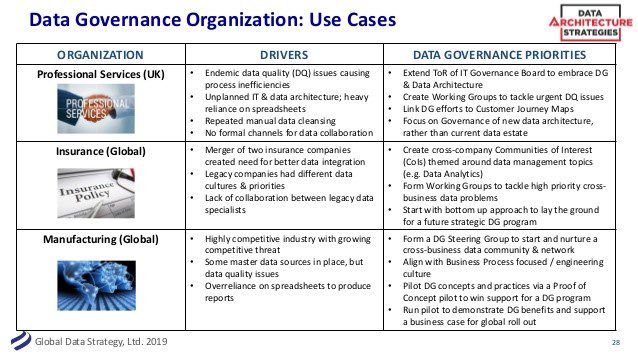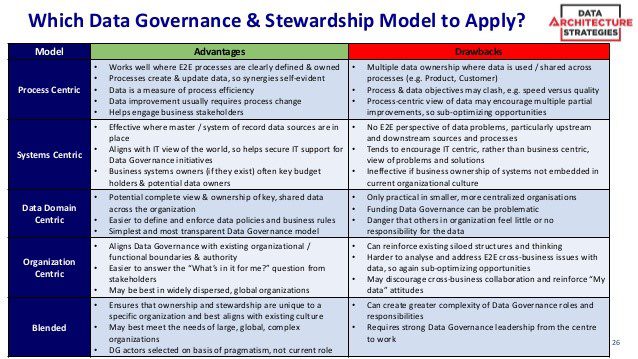
Data Governance practices need to mature. Data Governance Trends in 2019 reports that dissatisfaction with the quality of business data continues in 2019, despite a growing understanding of Data Governance’s value.
Harvard Business Review reports 92 percent of executives say their Big Data and AI investments are accelerating, and 88 percent talk about a greater urgency to invest in Big Data and AI. In order for AI and machine learning to be successful, Data Governance must also be a success. Data Governance remains elusive to the 87 percent of businesses which, according to Gartner, have lower levels of Business Intelligence.
Recent news has also suggested a need to improve Data Governance processes. Data breaches continue to affect customers and the impacts are quite broad, as an organization’s customers (including banks, universities, and pharmaceutical companies) must continually take stock and change their user names and passwords. Effective Data Governance is a fundamental component of data security processes.
Data Governance has to drive improvements in business outcomes. “Implementing Data Governance poorly, with little connection or impact on business operations will just waste resources,” says Anthony Algmin, Principal at Algmin Data Leadership.
To mature, Data Governance needs to be business-led and a continuous process, as Donna Burbank and Nigel Turner emphasize. They recommend, as a first step, creating a Data Strategy, bringing together organization and people, processes and workflows, Data Management and measures, and culture and communication. Then creating and choosing a Data Governance Framework. Most importantly, periodically testing that Data Governance Framework.
To truly be confident in Data Governance structures, organizations need to do the critical testing before a breach or some other unexpected event occurs. It is this notion—implementing some testing—that is missing in much current Data Governance literature. Thinking like a software tester provides an alternative way of learning good Data Governance fundamentals.
Before Testing, Define Data Governance Requirements
Prior to offering feedback on any software developed, a great tester will ask for the product’s requirements to know what is expected and to clarify important ambiguities. Likewise, how does an organization know it has good Data Governance without understanding the agreed-upon specifications and its ultimate end? First, it helps to define the what Data Governance is supposed to do. DATAVERSITY® defines Data Governance as:
“A collection of practices and processes which help to ensure the formal management of data assets within an organization. Data Governance often includes other concepts such as Data Stewardship, Data Quality, and others to help an enterprise gain better control over its data assets.”
How Data Governance is implemented depends on business demands specifically leading to a Data Governance solution in the first place. This means breaking down the data vision and strategy into sub-goals and their components, such as a series of use cases. Nigel Turner and Donna Burbank give the following use case examples:

Image Credit: Global Data Strategy
Combining the Data Governance definition with use case priorities, leads to a set of deliverables. For example, in the use cases above:
- A professional services (UK) Working Groups may decide to tackle Data Quality inconstancies through a business glossary or a data dictionary, starting with a few customer journeys, as required by the Data Governance priorities.
- A global insurance company, tasked with creating cross-company communities and interest, may form Data Governance regulation bodies with the right people to better integrate and solve problems. The people on the committees may define conflict resolution policies around high-priority items, which would be a Data Governance product.
- A manufacturing company might do an assessment report identifying a product or process for which to run a Data Governance pilot study. The report would need to meet the Data Governance priorities of demonstrating the required benefits.
Once an organization is in process with a deliverable, and prior to testing, questions and clarifications can be made about the expected outcome and the needs to get there. Testing happens when an agreed upon deliverable or part of deliverable has been accepted and the company intends to act upon these deliverables.
Data Governance Testing Coverage
With the requirements and Data Governance deliverables in hand, why not just skip the testing and just continue implementing Data Governance? Without testing, organization subject their processes to risks.
Is it practical to assess every single scenario with every single data steward and member engaged in Data Governance? No. There is just not enough time and money to do so. Also, people cannot always be tested rationally. However, organizations can decide how well their Data Governance processes work to mitigate unexpected challenges. It is a matter of coverage; spelling out a reasonable set of challenges, figuring out the gaps and addressing them before acting upon Data Governance deliverables in real life—a production environment.
For example:
- Businesses change. They develop new products, experience different pressure points over time and due to shifting regulatory requirements. Wouldn’t it make sense to provide top-level managers a sense of how well the current Data Governance structures and practices will likely fare when a new type of product is released?
- Maybe employees just do not trust Data Quality and there is a desire for more buy-in. Depending on company culture and organization, engaging the fiercest Data Governance critics to try to break the Data Governance policies, in a systematic and well-thought-out way, may get some buy in. Some people are swayed by facts.
- Testing Data Governance deliverables can identify aspects of the Data Strategy or Data Governance specifications that need updating. For example, a company might need to clarify how to deal with non-financial data as a business to formalize Data Governance operations.
- Determining silos ahead of time may be easier with some good tests of Data Governance processes and procedures. It would be nice to find, out ahead of time, that sales and IT need to share the product information that they separately collect. At the same time, maybe storing data in an Excel sheet, separately, poses little danger of losing data’s values. Do IT, sales, and other business departments really need to know the sign-up to the annual company picnic? Would keeping the name of the face painter that entertained the employees at the picnic in 2016 prove a necessary business asset?
Testing to Find a Good Data Governance Framework
Once businesses define requirements, deliver some sort of Data Governance product, know what chances it would rather not take, and choose a Data Government Framework, tests can be written and conducted. Donna Burbank and Nigel Turner have developed a chart detailing strengths and weaknesses of each model.

Image Credit: Global Data Strategy
This could be a good starting place. For instance, if the professional services organization mentioned above decided on a Systems Centric Data Governance model, then it may be worthwhile to come up with a few complicated Customer Journey maps to test the effectiveness of Data Governance deliverables. Have a tester pose as or email as a customer and run through the scenarios. Assess and rate which resources are used and how well IT and business work together for resolution and speedy outcome. See if the business glossary helps IT and Business to work together for a speedy resolution and where the terminology is ignored. If this approach is not practical, then do a thought experiment to see how Data Governance processes could potentially break before putting them in practice.
Conclusion
Mature Data Governance needs to drive business. To achieve this, businesses have to test their processes. There are many different test types and combinations. Yes, testing may not provide all the answers and other approaches may also be needed. However, it is far better to have some understanding and data points about a Data Governance model and potential business risks then to leave it to chance.
Image used under license from Shutterstock.com
